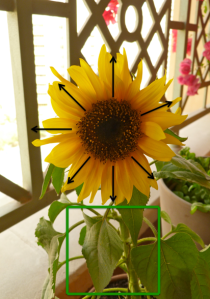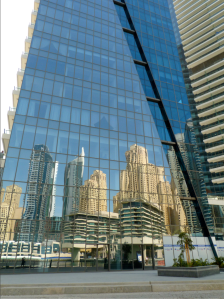View a scene through the camera viewfinder and consider the different positions in which you could arrange the horizon line in the frame.
This exercise required me to consider the ways in which the horizon could be used to divide the frame and to note the effect this may have on the photograph and the viewer.
Using my wide-angle lens, I took a short series of photographs looking across Lake Zürich. As it conformed comfortably to the landscape view I composed the photographs in a horizontal frame using far side of the lake as the horizon line.
For the first photograph I decided to place the horizon low in the frame.
This image shows rows of boats moored upon the lake. However, I found that my eye was quickly drawn up towards the cloud formations in the sky, which dominate 2/3 of the photograph. The horizontal frame and low horizon both give a sense of stability to the image.
This viewpoint also included foliage which offers a frame to the image on 3 sides. At the time I composed this shot I felt as though this frame helped add depth to the image. I since, however, have read Präkel’s text on Composition which notes that while framing with overhanging tree branches is popular in landscape photography its execution is often not successful. He suggests that rather than have isolated branches hang into the frame it is better to show the tree trunk to which the branch is attached to one side of the frame with the overhanging branches to the top. This is something I could have tried here had I adjusted my position slightly.
The second photograph of the series shows the horizon line placed at approximately the mid-point of the image, dividing the frame into 2 distinct areas. This viewpoint gives equal importance to the lake and boats and to the sky. With the horizon placed at this point a large section of blue sky, which I felt added interest to the first image, is lost. This composition did not encourage me to ‘look’ at the whole photograph but merely to concentrate on the horizon details. The overall impression of this image could be considered to be safe and conventional.
In the third photograph the horizon line is placed higher in the frame giving priority to the foreground; the lake. This encouraged me to look across the lake from left and right and then also to look up and down, noticing the ripples on the water suggesting a little movement. The sky area is smaller now and offers little graphic interest.
In the fourth photograph the horizon is placed very high in the frame which adds more depth to the image. Again, I feel as though the eye is encouraged here to look both left to right and up and down within the image. The lake, in the foreground, has little detail to hold a viewer’s interest. The sky appears gray and unremarkable but this did encourage me to look a little longer at the hills and buildings in the distance, possibly in a search for colour or form.
While these four images were taken from the same viewpoint, moving the horizon has changed the overall effect. I believe the strongest image is the Lake Zürich 1, despite the overhanging branch. This view shows the lake, while giving priority to the sky encouraging the viewer to look across the lake and up to the sky. The viewpoint didn’t have enough interest in the foreground to merit a high-placed horizon.
One practical problem I noticed during this exercise is my tendency to tilt the camera when taking photographs, which resulted in images of horizon lines on a slight diagonal. When discussing line in his Composition text, Präkel emphasises the need for careful alignment of the horizon line in order to create a stable image. He notes that some photographers use a bubble level to remedy this.




























